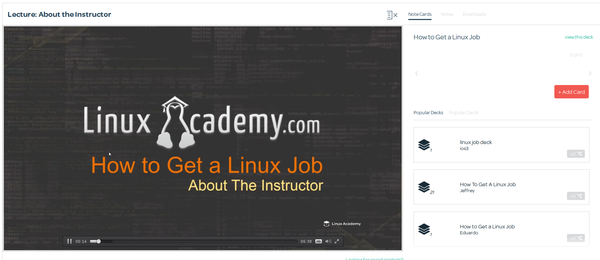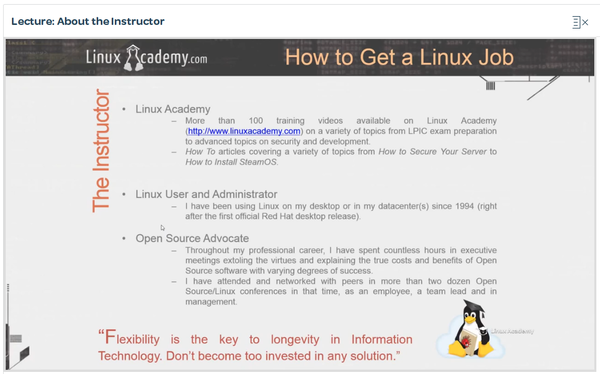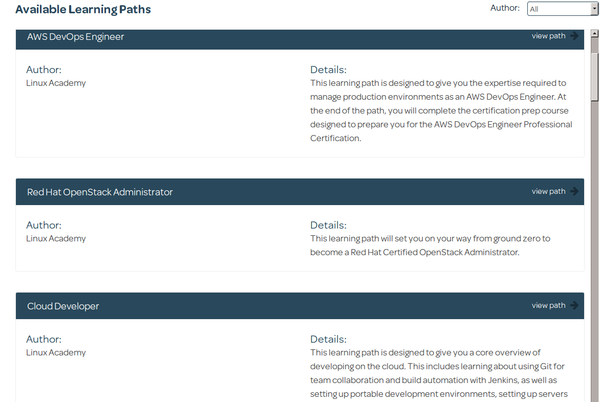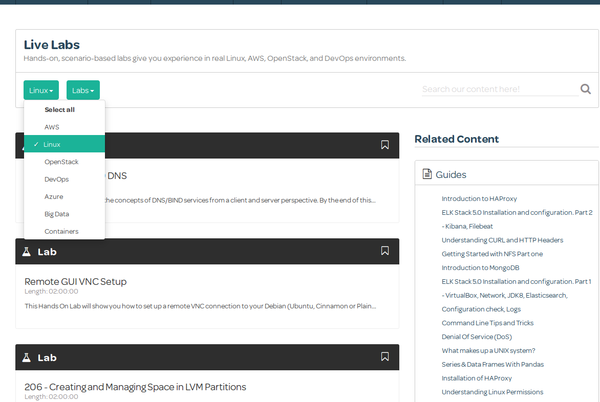Learning with Linux Academy
Open Source Education
ByOpen source experience is in high demand, and Linux Academy can give you a leg up if you are looking for employment in the open source job market.
According to the Linux Foundation’s 2016 report, 87% of hiring managers have difficulty finding the talent they need, and 79% have increased incentives to retain their current open source talent.
Faced with this demand, where can you go to gain the experience necessary to find work? As an occasional designer of on-line courses, one answer I would recommend is the Linux Academy, an online training organization that offers lessons not only in Linux, but also in other open source–related topics, such as Amazon Web Services (AWS), OpenStack, DevOps, Azure, Big Data, and containers, with new and quick training courses being added regularly as the demand increases. Although the Linux Academy does not itself offer certification beyond grading its courses, the intent is to prepare students for existing certification courses, such as the Red Hat Certified System Administrator exam or the credentials offered by the Linux Professional Institute – more than 20 in all.
Linux Academy was founded by current CEO Anthony James. “Linux Academy came from my own need for training,” James said. “My learning style is such that I need videos. I need to do it hands-on, I need to practice, and then I need to study/memorize to commit things into memory.” James is apparently not alone in his learning style, because thousands have now passed through Linux Academy, which they consistently grade as preferable to other online training sites. One Reddit page, for example shows Linux Academy consistently preferred over Cloud Academy, and one alumni compares it favorably with comparable courses and describes it as much less confusing than the courses offered by CompTIA, whose study guide by itself was “an obstacle to study.”
Course Material
Students can register with Linux Academy either individually or in teams, which adds the possibility of in-person study sessions and training. Study takes place online, either with a Flash-equipped browser or an Android or iOS app that allows off-line study. HTML5 videos, which remove the need for Flash, are currently in development, although in my own series of random tests, they did not run.
Courses take the form of a series of videos with slides and voiceovers (Figure 1). According to James, Linux Academy can create a quick training course of a couple of hours or less in “as little as seven days.” However, certification courses, with their supporting material (see below) generally take two to three months. “The goal,” says James, “is to ensure we present the proper content in the correct order, cover all objectives, and teach the student to be proficient and qualified at the level at which the exam requires. Our training teaches students how to do it, not just how to pass an exam.”

To judge by the Linux courses of study – the area I am most competent to evaluate – Linux Academy videos maintain a generally high standard. The voiceovers go beyond simply reciting the information on the slides, usually beginning with the narrator’s credentials (Figure 2), then describing the certification that each course is designed to prepare students for, and discussing the prerequisites for the course. The courses then continue in videos ranging from 3 to 30 minutes, mixing both technical instruction and explanation of the open source community.

Experts might quibble over some of the details of the course. The fact that one instructor pronounces “Debian” as “Dee-be-an” is grating, but trivial. More serious is the emphasis on Red Hat and CentOS in the beginning section of Linux Essential Certification and the relative neglect of Debian and its Ubuntu and Linux Mint derivatives, by far the most popular distributions today. It might be argued that, given the size of the Red Hat company, this emphasis will be the most help for job seekers, although Ubuntu’s prominence in OpenStack suggests the need for more balance.
Similarly, although systemd has been a fact of running Linux for several years, I was unable to find any course that mentioned it, let alone one that described in detail its role in administration. Nor is DNF, the new standard Fedora package manager, described; instead, the coverage of RPM package management concentrates on the now-deprecated Yum.
Still, despite such issues, in its Linux courses, Linux Academy has usually made a fitting selection and ordering of topics, giving enough information that it accomplishes its aims of preparing students for certification.
Student Resources
Students begin taking Linux Academy courses by choosing their learning paths – that is, their curriculum and their goals. As they start a course, they can review its syllabus and design a study plan based on their available hours through the week (Figure 3), setting reminders for themselves. Should students fail to keep their self-chosen hours, they are reminded of the fact the next time they start the course for study. If students are part of a corporate team, their managers can set schedules for the entire team. However, whether students are individuals or members of a team, they can export their course of study to their own calendars.

The Linux Academy recommends creating study groups, which can be private or public and are overseen by instructors. Justin Overstreet, VP of Business Development, adds that study groups can be further subdivided into smaller groups, more tailored to each student’s particular needs. General online forums are also available.
Many courses demonstrate directly from the command line, and students are encouraged to log in and imitate the actions shown in the course. Some courses – although not as many as might be ideal – include lab problems for additional hands-on experience (Figure 4). All courses allow the creation of decks of cards and cards made by other students to help when studying.

When students want to test their knowledge, some courses offer quizzes that must be answered in a set period of time, with a minimum of errors. The standards of these quizzes is high, with one quiz failing students with two mistaken answers out of 10.
Obviously, the usefulness of these resources depends on how the students use them, although Linux Academy automatically nudges those who fall behind in their schedules. However, the array of resources is thorough, balancing contact with instructors and study aids and compensating for the potential limitations of videos and slide shows.
Overcoming Online Limitations
Linux Academy did not give any statistics about the percentage of students who go on to pass certifications. However, anyone who has designed online courses or taken them can see the efforts it makes to overcome the natural limitations of online courses by dividing course material into small chunks and providing additional teacher contact and a variety of study methods, ranging from the hands-on to rote.
Based on my sampling, Linux Academy might do more fact-checking and update courses more frequently. Overall, however, it sets high standards, and my educated guess is that it generally does what it claims to do: prepare students to pass certifications. Assuming students have the discipline to put in the necessary amount of work, it should go a long way toward helping them reach their goals.
Subscribe to our Linux Newsletters
Find Linux and Open Source Jobs
Subscribe to our ADMIN Newsletters
Support Our Work
Linux Magazine content is made possible with support from readers like you. Please consider contributing when you’ve found an article to be beneficial.

News
-
Manjaro 26.0 Primary Desktop Environments Default to Wayland
If you want to stick with X.Org, you'll be limited to the desktop environments you can choose.
-
Mozilla Plans to AI-ify Firefox
With a new CEO in control, Mozilla is doubling down on a strategy of trust, all the while leaning into AI.
-
Gnome Says No to AI-Generated Extensions
If you're a developer wanting to create a new Gnome extension, you'd best set aside that AI code generator, because the extension team will have none of that.
-
Parrot OS Switches to KDE Plasma Desktop
Yet another distro is making the move to the KDE Plasma desktop.
-
TUXEDO Announces Gemini 17
TUXEDO Computers has released the fourth generation of its Gemini laptop with plenty of updates.
-
Two New Distros Adopt Enlightenment
MX Moksha and AV Linux 25 join ranks with Bodhi Linux and embrace the Enlightenment desktop.
-
Solus Linux 4.8 Removes Python 2
Solus Linux 4.8 has been released with the latest Linux kernel, updated desktops, and a key removal.
-
Zorin OS 18 Hits over a Million Downloads
If you doubt Linux isn't gaining popularity, you only have to look at Zorin OS's download numbers.
-
TUXEDO Computers Scraps Snapdragon X1E-Based Laptop
Due to issues with a Snapdragon CPU, TUXEDO Computers has cancelled its plans to release a laptop based on this elite hardware.
-
Debian Unleashes Debian Libre Live
Debian Libre Live keeps your machine free of proprietary software.
